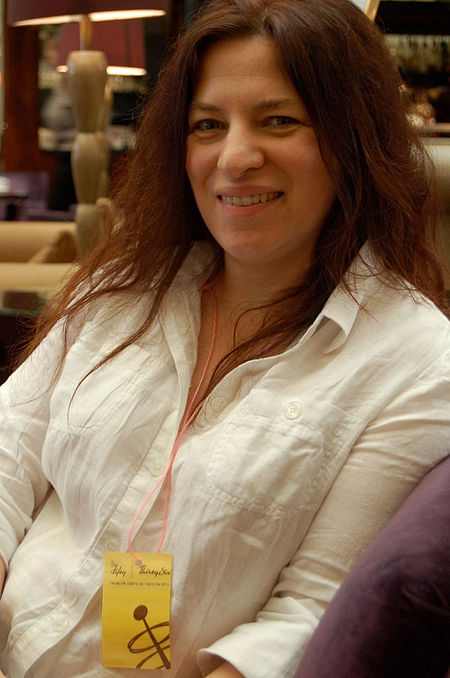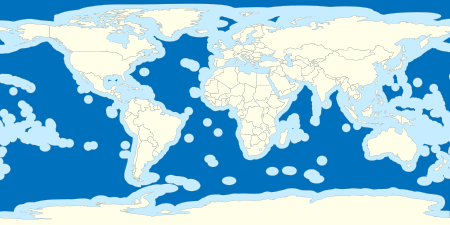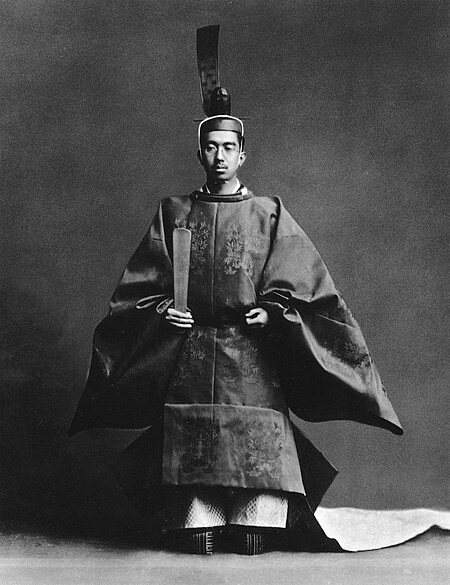Proto-industrialization
| ||||||||||||||||||||
Read other articles:

The condition index in fish is a way to measure the overall health of a fish by comparing its weight with the typical weight of other fish of the same kind and of the same length. The condition index is its actual weight divided by its expected weight, times 100%. A fish of normal weight has a condition index of 100 percent. So if a tarpon, for example, has a condition index of 104 percent, that would mean it is above the normal weight for an average tarpon of that length. If a tarpon has a cond…

The military ranks of Manchukuo were the military insignia used by the Manchukuo Imperial Army, the Manchukuo Imperial Navy, and the Manchukuo Imperial Air Force during its existence, from its founding in 1932 until the Soviet invasion in 1945. Corps colours Colour Branch Black Military police Red Infantry Green Cavalry Yellow Artillery Brown Engineers Blue Transport corps Source: [1] Commissioned officer ranks The rank insignia of commissioned officers. Rank group General / flag officer…

Province of North Korea This article is about the province of North Korea. For the hypothetical province claimed by South Korea, see South Pyeongan Province (Republic of Korea). Province in Kwanso, North KoreaSouth Pyongan Province 평안남도ProvinceKorean transcription(s) • Chŏsŏn'gŭl평안남도 • Hancha平安南道 • McCune-ReischauerP'yŏng'annam-do • Revised RomanizationPyeong-annam-doCountry North KoreaRegionKwansoCapitalP…

Mayor Jenderal TNI (Purn)Mas Isman Anggota Dewan Perwakilan RakyatMasa jabatan1 Oktober 1977 – 12 Desember 1982PenggantiSuyoto HardjosutowoDaerah pemilihanJawa TimurDuta Besar Indonesia untuk Mesir ke-6Masa jabatanSeptember 1964 – Desember 1966PresidenSoekarnoPendahuluSanusi HardjadinataPenggantiAhmad Yunus MokogintaDuta Besar Indonesia untuk Thailand ke-4Masa jabatan1961–1964PresidenSoekarnoPendahuluMohammad IchsanPenggantiB. M. Diah Informasi pribadiLahir(1924-0…

Square UpSampul versi Digital dan PinkAlbum mini karya BlackpinkDirilis15 Juni 2018 (2018-06-15)Genre K-pop[1] hip hop[2] Durasi14:03Bahasa Korea Inggris LabelYGProduser Teddy Bekuh Boom Future Bounce R.Tee 24 Choice37 Kronologi Blackpink Blackpink(2017) Square Up(2018) Blackpink in Your Area(2018) Singel dalam album Square Up Ddu-Du Ddu-DuDirilis: 15 Juni 2018 (2018-06-15) Square Up (ditulis sebagai SQUARE UP) adalah album mini pertama dari grup vokal wanita asal K…

British writer Justina RobsonBorn (1968-06-11) June 11, 1968 (age 55)Leeds, EnglandGenreSpeculative fictionNotable worksQuantum Gravity SeriesNotable awardsArthur C Clarke (nominee), BSFA (nominee), John W Campbell (nominee)Justina Robson (born 11 June 1968 in Leeds, England) is a science fiction author from Leeds, England. Biography and publishing history Justina Robson was born in Leeds on 11 June 1968,[1] and studied philosophy and linguistics at the University of York. She worke…

Cet article est une ébauche concernant la mer et le droit. Vous pouvez partager vos connaissances en l’améliorant (comment ?) selon les recommandations des projets correspondants. Les zones maritimes du droit international de la mer Les eaux territoriales ou mers territoriales sont la partie de mer côtière sur laquelle s'étend la souveraineté d'un État côtier. Sa largeur maximale est fixée à 12 milles marins (soit 22 224 mètres) par la Convention des Nations unie…

2006 novel by Rachel Cohn and David Levithan Nick and Norah's Infinite Playlist First edition coverAuthorRachel Cohn and David LevithanCountryUnited StatesLanguageEnglishPublisherAlfred A. Knopf Books for Young ReadersPublication dateMay 23, 2006ISBN9780375835315 hardcover Nick and Norah's Infinite Playlist is the first collaboration novel written by Rachel Cohn and David Levithan. The novel was published in 2006 by Alfred F. Knopf Books for Young Readers. It was adapted into the 2008 feature fi…

本條目存在以下問題,請協助改善本條目或在討論頁針對議題發表看法。 此條目需要編修,以確保文法、用詞、语气、格式、標點等使用恰当。 (2013年8月6日)請按照校對指引,幫助编辑這個條目。(幫助、討論) 此條目剧情、虛構用語或人物介紹过长过细,需清理无关故事主轴的细节、用語和角色介紹。 (2020年10月6日)劇情、用語和人物介紹都只是用於了解故事主軸,輔助讀�…

Political view advocating a return to a previous state of society See also: Revanchism and Irredentism Part of a series onConservatism Variants Authoritarian Corporatist Cultural Fiscal Green Liberal Libertarian Moderate National Paternalistic Populist Pragmatic Progressive Reactionary Religious Social Traditionalist Ultra Principles Ancestral worship Authority Traditional Class collaboration Collective identity Cultural heritage Cultural values Culture of life Pro-Life Discipline Duty Elitism A…

Social networking, microblogging and messaging tool Google BuzzType of siteSocial networking serviceAvailable inMultilingualPredecessor(s)Google Wave (2009–2010)Successor(s)Google+ (2011–2019)OwnerGoogleURLFormer location: www.google.com/buzzCommercialYesRegistrationRequiredLaunchedFebruary 9, 2010; 14 years ago (2010-02-09)Current statusDiscontinued – December 15, 2011; 12 years ago (2011-12-15) Google Buzz was a social networking, microbloggi…

Respuesta de la Unión Europea a la invasión rusa de Ucrania Parte de la refundación de la Unión Europea y la construcción del relato europeo. La Torre Eiffel durante la presidencia francesa del Consejo de la UE en 2022.Fecha 24 de febrero de 2022 – presente (2 años, 3 meses y 17 días)Lugar Unión EuropeaAcción Aumento de las sanciones impuestas por la UE a Rusia Aumento de la ayuda (humanitaria, política, económica y militar) de la UE a Ucrania.Causas Invasión r…

County in Texas, United States County in TexasLee CountyCountyCounty courthouse in Giddings, built 1899 SealLocation within the U.S. state of TexasTexas's location within the U.S.Coordinates: 30°19′N 96°58′W / 30.31°N 96.96°W / 30.31; -96.96Country United StatesState TexasFounded1874Named forRobert E. LeeSeatGiddingsLargest cityGiddingsArea • Total634 sq mi (1,640 km2) • Land629 sq mi (1,630 km2) …

Australian politician John CannJohn Cann in 190225th Chief Secretary of New South WalesIn office29 Jan 1914 – 15 Mar 1915PremierWilliam HolmanPreceded byWilliam HolmanSucceeded byGeorge Black32nd Treasurer of New South WalesIn office6 May 1912 – 29 Jan 1914PremierJames McGowenWilliam HolmanPreceded byCampbell CarmichaelSucceeded byWilliam HolmanMember of the New South Wales Legislative Assemblyfor SturtIn office20 June 1891 – 25 June 1894Preceded byWyman …

Scottish painter Alison Watt OBE FRSE RSA (born 1965) is a British painter who first came to national attention while still at college when she won the 1987 Portrait Award at the National Portrait Gallery in London.[1][2][3] Biography Alison Watt. Self-portrait, 1986–87. Oil on canvas, 30.80 x 30.80 cm. Scottish National Portrait Gallery Watt was born in Greenock, Scotland. She studied at Glasgow School of Art, graduating in 1988.[4] While a student, she came to…

Artikel ini sebatang kara, artinya tidak ada artikel lain yang memiliki pranala balik ke halaman ini.Bantulah menambah pranala ke artikel ini dari artikel yang berhubungan atau coba peralatan pencari pranala.Tag ini diberikan pada Februari 2023. Ini adalah nama Jepang, nama keluarganya adalah Inukai. Takeru InukaiInukai TakeruLahir28 Juli 1896Tokyo, JepangMeninggal28 Agustus 1960Tokyo, JepangPekerjaanpenulis, politikusGenrenovel, drama panggung Takeru Inukai (犬養 健code: ja is deprecated , I…

Questa voce o sezione sull'argomento gruppi musicali italiani non cita le fonti necessarie o quelle presenti sono insufficienti. Commento: Fonti autorevoli assenti Puoi migliorare questa voce aggiungendo citazioni da fonti attendibili secondo le linee guida sull'uso delle fonti. Segui i suggerimenti del progetto di riferimento. Eterea Post Bong Band Paese d'origine Italia GenerePost-rockElectronic dance music Periodo di attività musicale1999 – in attività Etichet…

Railway station in Israel Ra'anana South railway stationתחנת הרכבת רעננה דרוםIsrael RailwaysThe underground platformsGeneral informationLocationRa'anana,IsraelCoordinates32°10′22″N 34°53′15″E / 32.17278°N 34.88750°E / 32.17278; 34.88750Line(s)Sharon RailwayPlatforms2Tracks2ConstructionParkingNoHistoryOpened3 July 2018; 5 years ago (2018-07-03)Electrified25 December 2021; 2 years ago (2021-12-25)Passengers20…

Director of the Medical Research Council (MRC) Laboratory of Molecular Biology (LMB) Professor Jan LöweFRSDirector of the MRC-LMBIncumbentAssumed office 2018Preceded bySir Hugh Pelham Personal detailsBorn (1967-07-14) 14 July 1967 (age 56)NationalityGermanAlma mater University of Hamburg (Diplom) Technical University of Munich (Dr. rer. nat.) Known forStructural biology of bacterial cytoskeletonsAwardsEMBO Member (2004)EMBO Gold Medal (2007)Scientific careerFields Structural …

Canadian record producer and songwriter This article is about the Canadian music producer. For other uses, see David Foster (disambiguation). David FosterOC OBCFoster in 2024Background informationBirth nameDavid Walter FosterBorn (1949-11-01) November 1, 1949 (age 74)Victoria, British Columbia, CanadaGenresClassicalpoprockgospelR&BjazzOccupation(s)Record producersongwriterarrangermusic executivefilm composerInstrument(s)KeyboardsPianoFrench hornYears active1971–presentLabelsVerveR…
